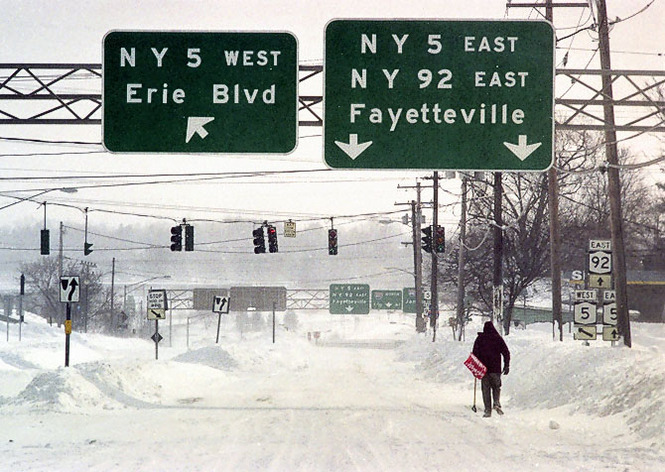
By: Nathan Everding, MD
SOS Upper Extremity Specialist
The holiday season is upon us and so is the long cold winter. With it, comes many joys like snowmen (and women), snowball fights, skiing, sledding, ice skating, snow days, beautifully lit houses and trees, and gatherings with family and friends. Along with the joys come some headaches in the form of slips, falls, icy roads and sidewalks, holiday traffic, fender benders, road closings, and shoveling snow.
Although in Upstate New York we are all experienced at dealing with cold, harsh, snowy conditions (whether we like it or not), it never fails that as the snow begins to fly, and the temperature drops, the emergency department will see a drastic increase in extremity and orthopedic injuries. Finger fractures, wrist fractures, elbow fractures, shoulder fractures, ankle fractures, hip fractures, frostbite, and amputations, just to name a few, can be caused by accidents in the harsh wintery conditions. Being prepared and aware of your surroundings can help prevent some of these problems. Make sure your winter gear is in good condition. Keep hats, gloves, a spare blanket, and even a small shovel in your car in case of emergency. Frostbite can occur in minutes, with devastating consequences, keep extremities and your face covered and warm. Make sure you have plenty of ice melt/salt to keep your driveways and walkways free of ice. Lastly, fire up your snow blowers now, because you never know when you will need them.

The Blizzard of 1993 - Photo by The Post Standard
Ah yes, the snow blower. Invented in 1925 by Arthur Sicard in Montreal, snow blowers are a blessing and an occasional curse. Snow blowers are a major asset to our winter preparedness and snow clean up ability. In March of 1993, as a young teenager, I remember spending an entire weekend shoveling snow off of our driveway and deck and begging my parents to buy a snow blower. We watched as the roof of the Carrier Dome deflated under the weight of the snow (and we didn’t even get a snow day out of it). Finally, they got one, a major difference maker. I hadn't had a negative thought about a snow blower until I began my orthopedic training. The first snowfall always carried with it a busy night of call. Page after page the beeper would ring with mangled hands and amputated fingers from people sticking their hands into clogged snow blowers. (If you don’t believe me…google images of snow blower injuries) Now as a hand surgeon, I won’t deny the impact a snow blower can have on an Upstate New York winter but a part of me will always cringe as the first appreciable storm hits. Somehow, despite our diminutive spring, summer, and fall, people seem to forget how to use a snow blower at the beginning of every winter.
The US Consumer Products Safety Commission reports that each year snow blower injuries are responsible for over 5,700 emergency room visits and nearly 600 of those require amputation. Most patients are male and the average age is 44 years old. 90% of injuries occur on the dominant hand with the middle finger being affected most often. However many injuries result in damage to multiple fingers. Most injuries are severe crushing type injuries with lacerations, fractures, and tendon injuries. Injuries can occur at the auger (intake), but also very commonly at the outflow chute. Snow will often get clogged as it exits the snow blower. The impeller is a rotating metal piece that propels the snow out of the chute, when the snow is cleared, the fingers are next. Simply turning off your snow blower does not protect you from injury. When the components get stuck they will often have a residual rotation once the clog is freed. Other injuries can occur from impact due to snow and debris being thrown, so watch where the snow is going.
Notably, heavy wet snow is most commonly associated with injury. Snowfall greater than six inches with temperatures at or above 28 degrees Fahrenheit increase s the chance of clogging.
SO HOW CAN YOU PROTECT YOURSELF FROM INJURY:
- Immediately turn off a jammed snow blower
- Disengage the clutch
- Use a long heavy stick or broom handle (I worry that the shovels the come with the snow blowers are not long enough) to clear the blockage
- Keep your hands and feet clear of moving parts
- Keep clear of the chute when clearing the blockage (you wouldn’t look down the barrel of a loaded gun, would you?)
- Lastly, don’t drink and blow. Operating heavy machinery under the influence of alcohol is never a good idea.
Enjoy all of the great things winter has to offer but take some time to get prepared. Check your closets and make sure your hats, gloves, coats, and boots are ready to go. Make sure you have plenty of salt/ice melt to keep your walkways and driveways safe. Keep a spare blanket in your car in the event that you are stranded in a storm. And…..Keep your hands out of the snow blower!!
The good news….Syracuse Orthopedic Specialists will be here to help with any of your wintery woes.
